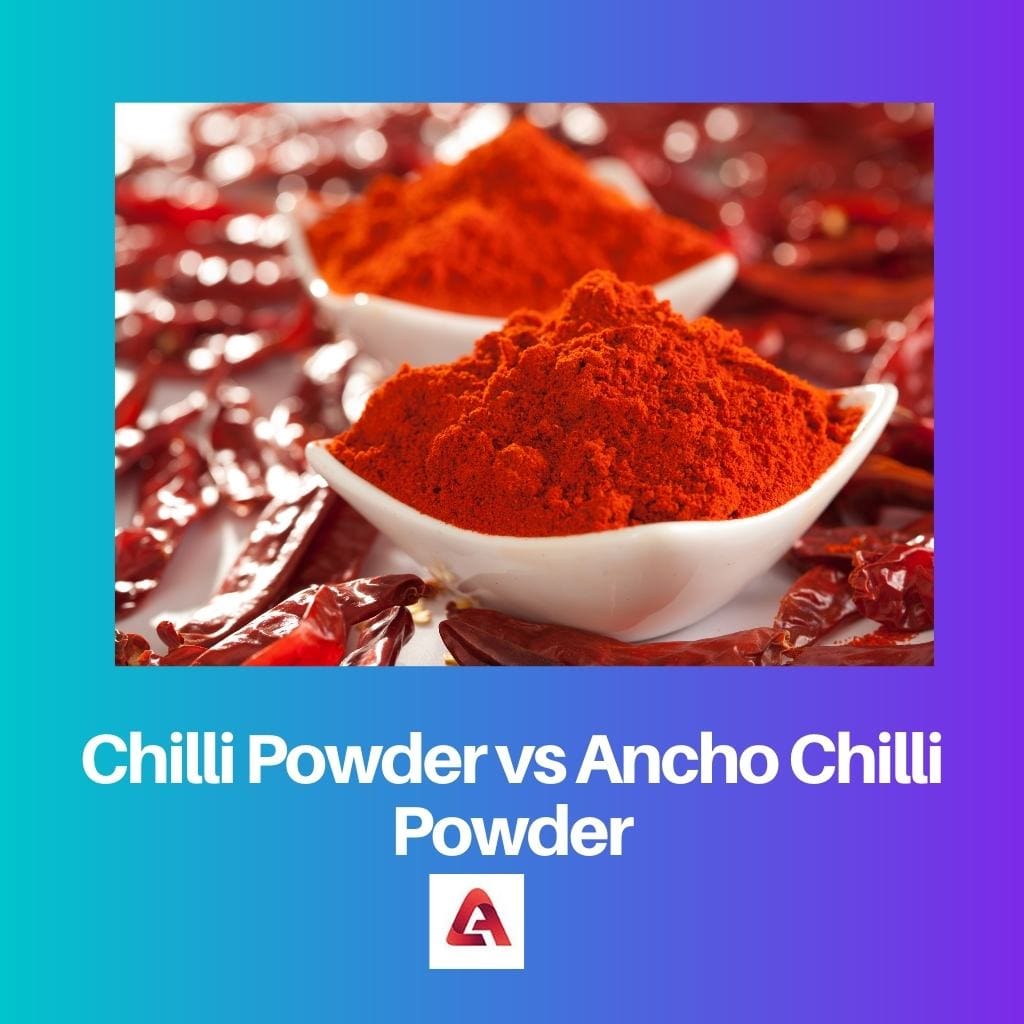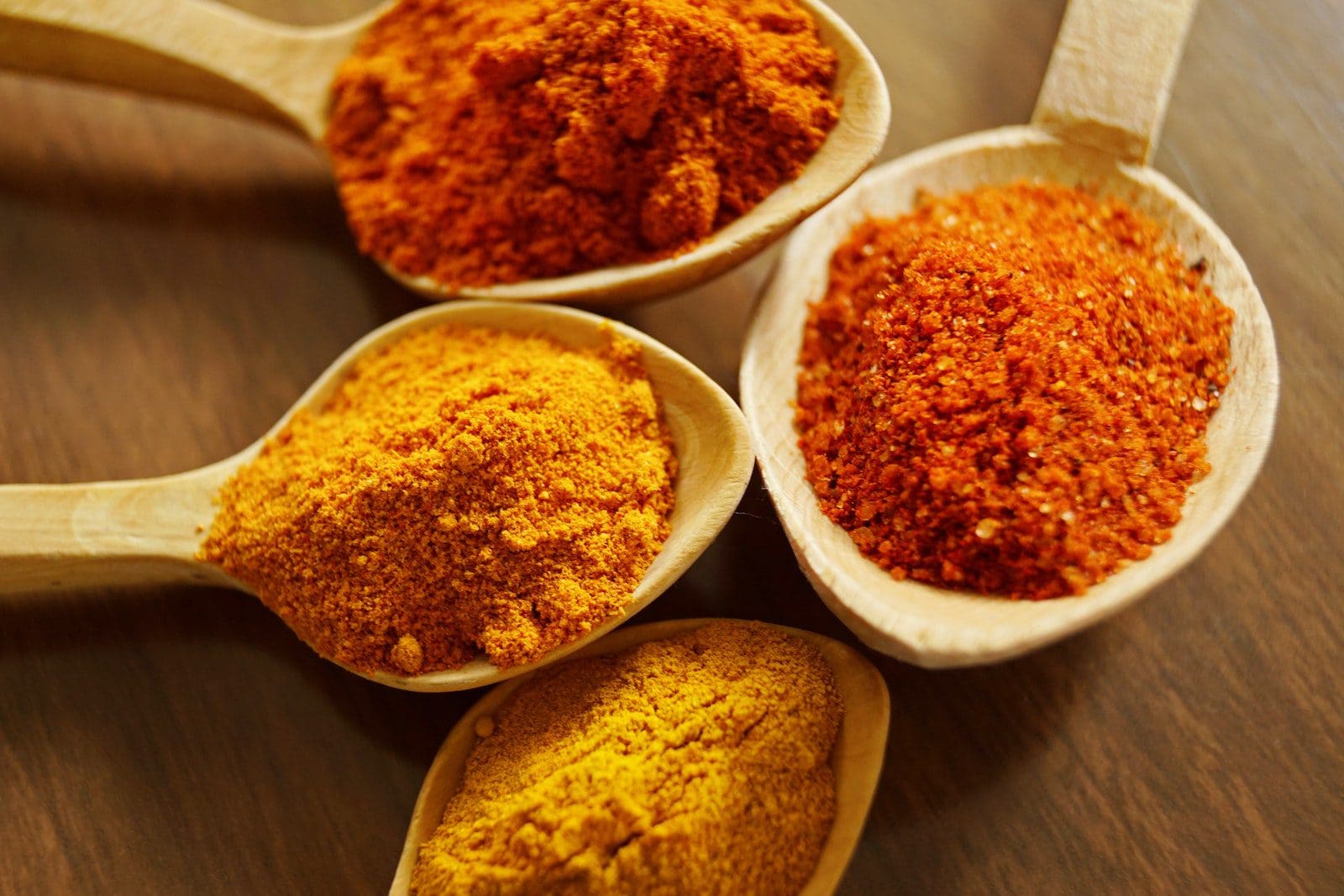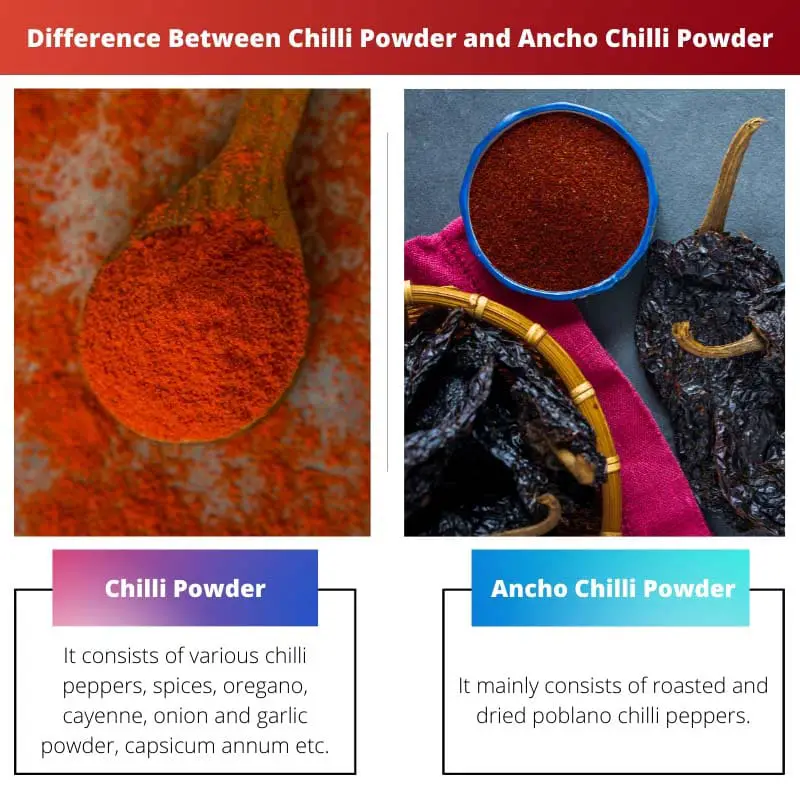Chili powder refers to a blend of spices, including ground dried chili peppers, whereas Ancho chili powder specifically comes from dried poblano peppers, offering a milder, slightly sweet flavor profile.
Key Takeaways
- Chilli powder is a spice blend made from dried chillies, while ancho chilli powder is made specifically from dried ancho chillies.
- Chilli powder is a versatile spice used in many dishes, while ancho chilli powder has a smoky and slightly sweet flavor and is used in Mexican cuisine.
- Chilli powder is hotter than ancho chilli powder.
Chilli Powder vs Ancho Chilli Powder
Chilli powder is a blend of dried and ground chilli peppers mixed with other spices like cumin and garlic powder; it has a medium heat level and is commonly used in Tex-Mex and Mexican cuisine. Ancho chilli powder is made from ground ancho chilli peppers, which are dried, smoked poblano peppers.

Chilli powder consists of many ingredients such as peppers, spices, onion powder, cayenne, garlic powder, and many chilli peppers. All the above constituents are mixed in pulverized form.
Ancho chilli powder is a special type made by powdering dried poblano. Ancho chilli powder is unique as it provides a combination of mild heat and a little bit of smoky sweetness.
The Scoville heat unit (SHU) (the primary scale for measuring heat intensity) for ancho chilli powder is around 1500 SHU. At the same time, the SHU of other chilli powders can range from 700 to tens of thousands of SHU.
The value varies depending on the chilli powder used. For instance, the ‘Naga Jolokia’, a chilli pepper grown in the regions of Assam, has one of the highest Scoville units, ranging to 855,000 SHU.
Comparison Table
| Feature | Chilli Powder | Ancho Chilli Powder |
|---|---|---|
| Origin | Blend of various dried chile peppers | Ground Poblano pepper (Pasilla pepper) |
| Color | Bright red to reddish brown | Deep red to dark brown |
| Heat Level | Mild to hot, depending on the blend | Mild |
| Flavor Profile | Earthy, smoky, with varying degrees of heat depending on the blend | Sweet, fruity, mildly smoky, with raisin and prune notes |
| Additives | May contain cumin, oregano, garlic powder, and salt | No additives |
| Uses | Chili, tacos, enchiladas, stews, marinades | Mole sauce, adobo sauce, marinades, sauces, dips |
| Availability | Widely available | May be less readily available than regular chili powder |
| Storage | Store in a cool, dark, airtight container | Store in a cool, dark, airtight container |
What is Chilli Powder?
Chili powder is a popular spice blend commonly used in various cuisines around the world, renowned for its distinctive flavor and heat. It is composed of ground dried chili peppers along with other complementary spices.
Composition
- Chili Peppers: The primary ingredient in chili powder is ground dried chili peppers. These peppers can vary widely in heat level and flavor, depending on the type used. Common chili pepper varieties include cayenne, ancho, chipotle, and more. Each variety contributes its unique taste and heat intensity to the blend.
- Complementary Spices: Apart from chili peppers, chili powder contains a mixture of other spices to enhance its flavor profile. These may include cumin, garlic powder, onion powder, paprika, oregano, and sometimes even cinnamon or cocoa powder. The exact blend can vary based on regional preferences and personal taste.
Flavor Profile
- Heat: The heat level of chili powder can range from mild to extremely hot, depending on the type and quantity of chili peppers used in the blend. Chili powders made from milder peppers like ancho or paprika will impart a gentle warmth to dishes, while those made from hotter varieties like cayenne or habanero can add a fiery kick.
- Flavor: In addition to heat, chili powder contributes complex flavor notes to dishes. The combination of spices in the blend creates a harmonious balance of earthiness, smokiness, sweetness, and pungency. The specific flavor profile can vary depending on the types and proportions of spices used in the blend.
Culinary Uses
- Seasoning: Chili powder is widely used as a seasoning for various dishes, including soups, stews, chili con carne, tacos, enchiladas, and marinades. It adds depth of flavor and a spicy kick to both meat and vegetarian dishes.
- Ingredient in Spice Blends: Chili powder serves as a key ingredient in many spice blends, such as taco seasoning, fajita seasoning, and barbecue rubs. Its versatility makes it an essential component in the kitchen for adding heat and flavor to a wide range of dishes.

What is Ancho Chilli Powder?
Ancho chili powder is a spice made from dried poblano peppers (Capsicum annuum). These peppers are harvested when fully ripe and then dried, resulting in a dark, wrinkled appearance. Ancho chili powder is a staple in Mexican cuisine and offers a unique flavor profile distinct from regular chili powder.
Characteristics
- Origin: Ancho peppers originate from Mexico and are a crucial ingredient in traditional Mexican cooking. They are one of the most commonly used chili peppers in Mexican cuisine due to their mild heat and rich, fruity flavor.
- Flavor: Ancho chili powder is prized for its mild heat and sweet, smoky flavor. Compared to regular chili powder, which contains a mix of different chili peppers and spices, ancho chili powder offers a more nuanced taste with prominent fruity notes and a deep, earthy undertone.
Production Process
- Drying: Ancho peppers are harvested when they reach full maturity, a dark red color. They are then dried, either by sun-drying or through a controlled drying process. During drying, the peppers develop their characteristic wrinkled appearance and concentrated flavor.
- Grinding: Once dried, the peppers are ground into a fine powder to create ancho chili powder. The grinding process releases the peppers’ natural oils, intensifying their flavor and aroma.
Culinary Uses
- Seasoning: Ancho chili powder is a versatile seasoning used in a wide range of dishes, including soups, stews, sauces, and marinades. Its mild heat and complex flavor make it suitable for enhancing the taste of both meat and vegetarian dishes.
- Mole Sauce: Ancho chili powder is a key ingredient in traditional Mexican mole sauces, adding depth of flavor and a rich, dark color to the sauce. Mole is a complex sauce made with various ingredients, including chili peppers, chocolate, nuts, and spices, and is served over meats or enchiladas.
Health Benefits
- Nutritional Value: Like other chili peppers, ancho peppers are rich in vitamins, minerals, and antioxidants. They contain vitamins A and C, as well as potassium and iron. Consuming ancho chili powder in moderation can contribute to a healthy diet.
- Capsaicin Content: Ancho peppers contain capsaicin, the compound responsible for their heat. Capsaicin has been associated with various health benefits, including pain relief, improved metabolism, and heart health, although consuming excessive amounts may cause discomfort.

Main Differences Between Chilli and Ancho Chilli Powder
- Pepper Variety:
- Chili powder is made from a blend of various chili peppers, which can include cayenne, jalapeño, or other hot peppers.
- Ancho chili powder specifically comes from dried poblano peppers, offering a milder, sweeter flavor profile compared to the diverse mix found in regular chili powder.
- Heat Level and Flavor:
- Chili powder can vary widely in heat level, depending on the types and proportions of chili peppers used in the blend.
- Ancho chili powder is known for its mild heat and distinct sweet, smoky flavor, imparted by the dried poblano peppers.
- Composition:
- Chili powder contains additional spices such as cumin, garlic powder, and paprika, contributing to its complex flavor profile.
- Ancho chili powder consists solely of ground dried poblano peppers, focusing on the unique taste of this specific pepper variety without the addition of other spices.
- Culinary Uses:
- Chili powder is a versatile seasoning used in a wide range of dishes, including soups, stews, chili con carne, and marinades, offering both heat and flavor.
- Ancho chili powder is popular in Mexican cuisine, particularly in dishes like mole sauce, where its mild heat and fruity flavor complement the other ingredients in the dish, providing depth and complexity.

I found this article to be quite engaging, particularly in its discussion of the various uses and benefits of chilli powders. It has enhanced my knowledge about different types of chilli powders and will definitely help me in my culinary experiments.
I agree with you. The article has definitely broadened my understanding of how to use different chilli powders in cooking. It was an enlightening read.
The article’s scientific approach to discussing the heat units and constituents of chilli powders was impressive. It was a well-articulated piece of work that provided in-depth insights into the world of spices.
I completely agree. The article was an excellent exploration of chilli powders and their distinctive characteristics. The scientific elements added credibility to the content.
The knowledge about different types of chilli powders and their use is very fascinating. I appreciate the detailed explanation of the heat units and constituents of each type. This article is very informative and well-researched.
Yes, the scientific explanation of Scoville units and how they vary across different chilli powders was enlightening. It’s clear that the author has done thorough research.
I completely agree. The detailed comparisons and historical background of chilli powders were very interesting to read.
The historical insights into the origins of different types of chilli powders were quite engaging. It was an educative read and provided valuable knowledge about the world of spices.
I found the information about chilli powders and their origins to be fascinating. This article was a great resource for understanding the nuances of spice varieties.
The article’s detailed exploration of chilli powders and their constituents was impressive. It was an enlightening read that deepened my understanding of spice varieties.
I completely agree. The article’s engaging analysis of chilli powders was commendable and added great value to the readers.
The comprehensive comparisons and detailed explanations in the article contributed to a holistic understanding of chilli powders. It was an informative piece of work.
The detailed explanations of chilli powders and their heat units were very informative. I appreciate the thorough analysis of different chilli powder varieties and their uses.
I completely agree with your assessment. The article provided an excellent overview of chilli powders and their diverse characteristics.
I found the comparisons between chilli powder and ancho chilli powder to be very insightful. The detailed analyses and explanations offered a comprehensive understanding of the differences between the two types of chilli powders.
The author’s in-depth exploration of chilli powders was highly educational. This article was a commendable analysis of different spice varieties.
Absolutely, the article effectively showcased the unique properties of both chilli powder and ancho chilli powder, making it a valuable resource for spice enthusiasts.
I found the article to be well-researched and comprehensive. The comparisons between chilli powder and ancho chilli powder were very detailed, and I now have a better understanding of their individual characteristics.
Absolutely, the comparison table provided a clear understanding of the differences between chilli powder and ancho chilli powder. It was an impressive piece of writing.
The scientific approach to analyzing the heat units and constituents of chilli powders was very impressive. I enjoyed reading this article.
The comparisons provided in the article were very effective in elucidating the differences between chilli powder and ancho chilli powder. It was an insightful read.
The historical and scientific dimensions of the article offered a comprehensive overview of chilli powders. It was an intellectually enriching read.
I agree with your assessment. The article successfully highlighted the distinct characteristics of various chilli powders, providing a deeper understanding of spice varieties.
This article presented a comprehensive overview of chilli powders, and the detailed explanations were very enlightening. The comparison table made it easy to understand the differences between chilli powder and ancho chilli powder.
I agree. The detailed breakdown of chilli powder constituents and the level of heat provided valuable insights into the realm of spices and their uses.
The author’s approach to differentiating chilli powders based on their constituents and heat levels was impressive. This article was an excellent educational resource.